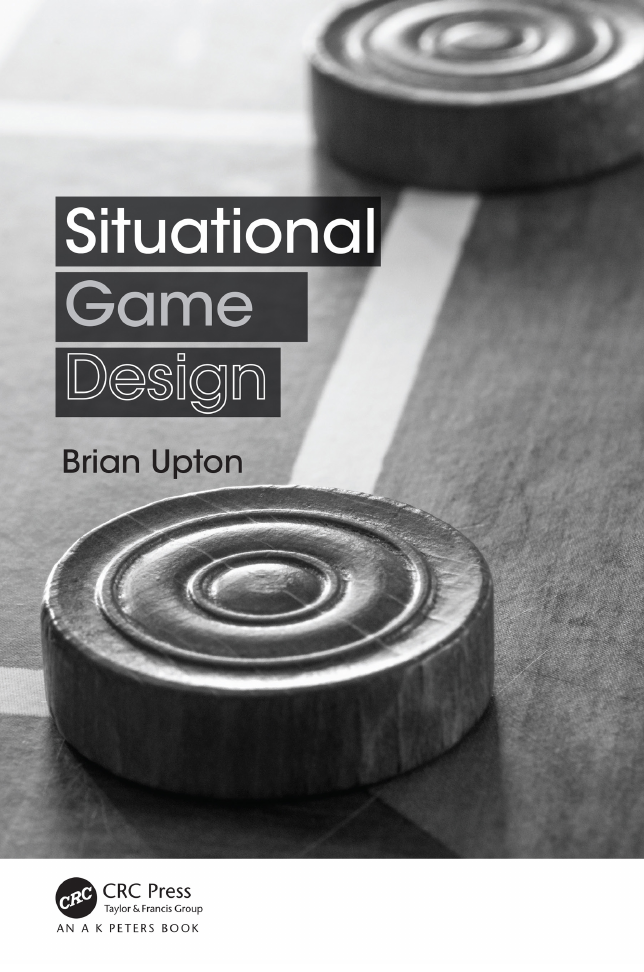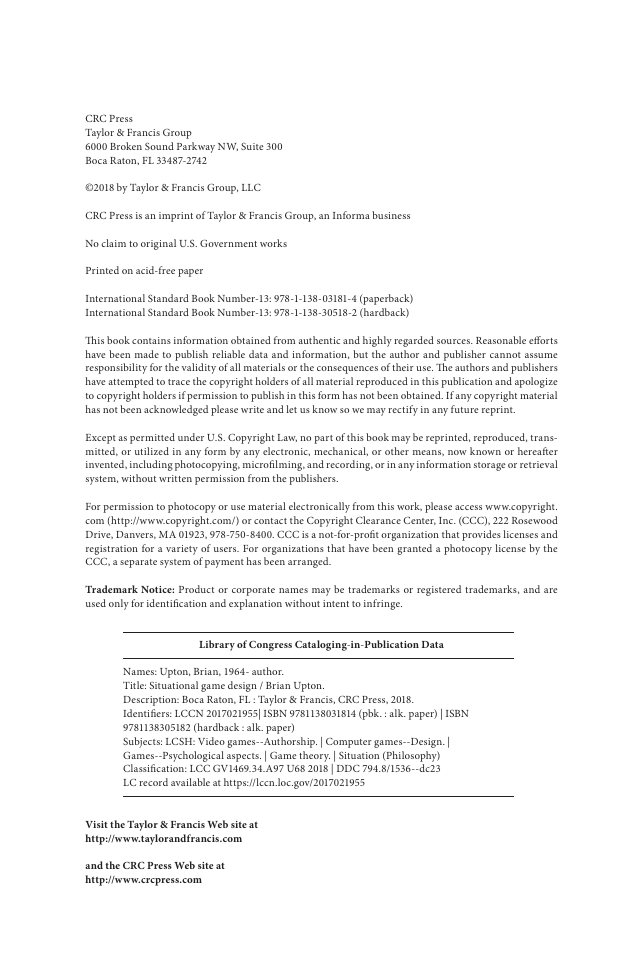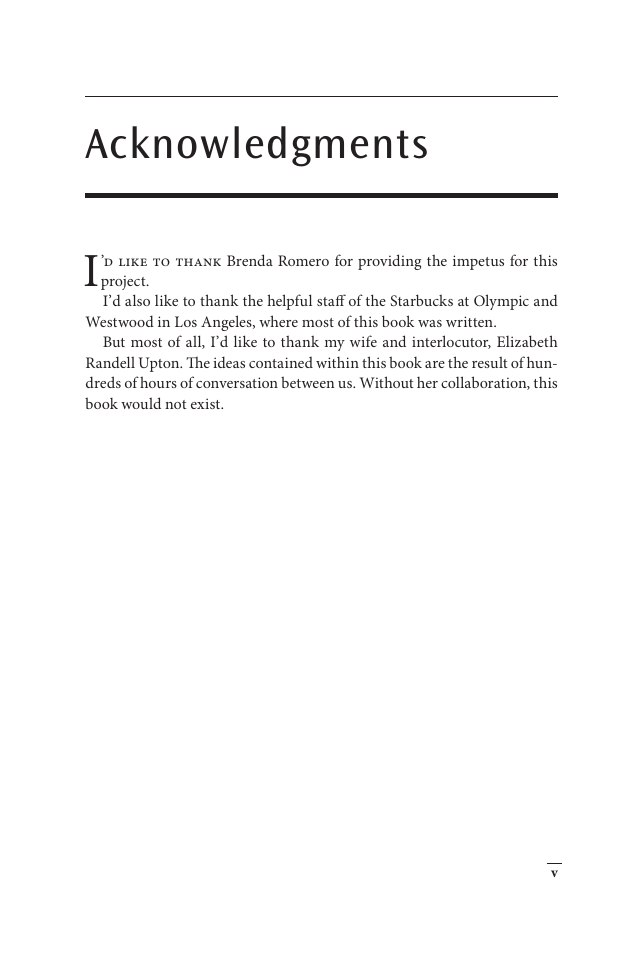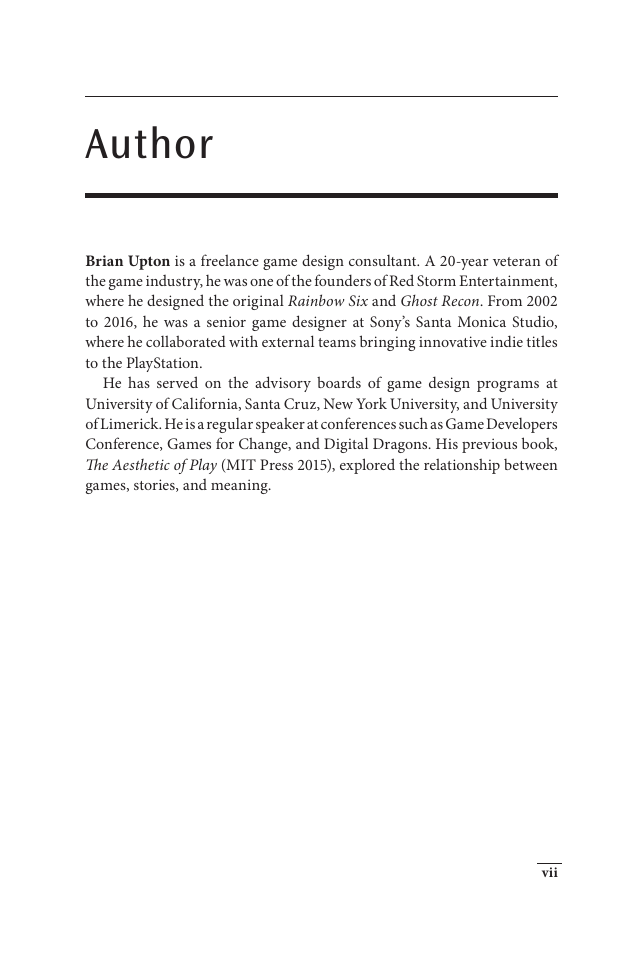�
Situational Game Design
Brian Upton
CRC Press
Taylor & Francis Group
6000 Broken Sound Parkway NW, Suite 300
Boca Raton, FL 33487-2742
©2018 by Taylor & Francis Group, LLC
CRC Press is an imprint of Taylor & Francis Group, an Informa business
No claim to original U.S. Government works
Printed on acid-free paper
International Standard Book Number-13: 978-1-138-03181-4 (paperback)
International Standard Book Number-13: 978-1-138-30518-2 (hardback)
This book contains information obtained from authentic and highly regarded sources. Reasonable efforts
have been made to publish reliable data and information, but the author and publisher cannot assume
responsibility for the validity of all materials or the consequences of their use. The authors and publishers
have attempted to trace the copyright holders of all material reproduced in this publication and apologize
to copyright holders if permission to publish in this form has not been obtained. If any copyright material
has not been acknowledged please write and let us know so we may rectify in any future reprint.
Except as permitted under U.S. Copyright Law, no part of this book may be reprinted, reproduced, trans-
mitted, or utilized in any form by any electronic, mechanical, or other means, now known or hereafter
invented, including photocopying, microfilming, and recording, or in any information storage or retrieval
system, without written permission from the publishers.
For permission to photocopy or use material electronically from this work, please access www.copyright.
com (http://www.copyright.com/) or contact the Copyright Clearance Center, Inc. (CCC), 222 Rosewood
Drive, Danvers, MA 01923, 978-750-8400. CCC is a not-for-profit organization that provides licenses and
registration for a variety of users. For organizations that have been granted a photocopy license by the
CCC, a separate system of payment has been arranged.
Trademark Notice: Product or corporate names may be trademarks or registered trademarks, and are
used only for identification and explanation without intent to infringe.
Library of Congress Cataloging-in-Publication Data
Names: Upton, Brian, 1964- author.
Title: Situational game design / Brian Upton.
Description: Boca Raton, FL : Taylor & Francis, CRC Press, 2018.
Identifiers: LCCN 2017021955| ISBN 9781138031814 (pbk. : alk. paper) | ISBN
9781138305182 (hardback : alk. paper)
Subjects: LCSH: Video games--Authorship. | Computer games--Design. |
Games--Psychological aspects. | Game theory. | Situation (Philosophy)
Classification: LCC GV1469.34.A97 U68 2018 | DDC 794.8/1536--dc23
LC record available at https://lccn.loc.gov/2017021955
Visit the Taylor & Francis Web site at
http://www.taylorandfrancis.com
and the CRC Press Web site at
http://www.crcpress.com
�
Contents
Acknowledgments, v
Author, vii
Chapter 1 ◾ Introduction
THE PROBLEM WITH WINNING
WHAT IS SITUATIONAL GAME DESIGN?
MAKING MEANING WITH GAMES
SUMMARY
Chapter 2 ◾ Situations, Constraints, and Moves
CONSTRAINTS
MOVES
THE GAME AS UNDERSTOOD
PRE-EXISTING CONSTRAINTS
INTERPRETIVE MOVES
SUMMARY
Chapter 3 ◾ Playfulness
CHOICE
VARIETY
CONSEQUENCE
PREDICTABILITY
UNCERTAINTY
SATISFACTION
SUMMARY
1
3
5
7
9
11
12
15
16
19
21
23
25
26
29
33
36
38
41
43
iii
�
iv ◾ Contents
Chapter 4 ◾ Anticipation
CHARACTERISTICS OF ANTICIPATORY PLAY
CUING CLOSURE
THE RESULT OF ANTICIPATORY PLAY
CRUXES
SUMMARY
Chapter 5 ◾ Goals
COHERENCE PLAY
EXPANSION PLAY
CLOSURE PLAY
SUMMARY
Chapter 6 ◾ Methods
DESIGNING MOVES
DESIGNING SITUATIONS AND CONSTRAINTS
DESIGNING GAMES
SUMMARY
Chapter 7 ◾ Narrative
NARRATIVE CONSTRAINTS AND SITUATIONS
NARRATIVE PLAY
GAMES AS STORIES
SUMMARY
Chapter 8 ◾ Meaning
THE LUDIC SIGN
THE EPISTEMOLOGICAL CYCLE
LUDIC SEMIOSIS
HOW GAMES MAKE MEANING
SUMMARY
INDEX, 117
45
46
49
51
53
56
59
61
64
67
69
71
74
76
78
83
85
86
90
96
98
101
102
104
108
112
116
�
Acknowledgments
I’d like to thank Brenda Romero for providing the impetus for this
project.
I’d also like to thank the helpful staff of the Starbucks at Olympic and
Westwood in Los Angeles, where most of this book was written.
But most of all, I’d like to thank my wife and interlocutor, Elizabeth
Randell Upton. The ideas contained within this book are the result of hun-
dreds of hours of conversation between us. Without her collaboration, this
book would not exist.
v
�
�
Author
Brian Upton is a freelance game design consultant. A 20-year veteran of
the game industry, he was one of the founders of Red Storm Entertainment,
where he designed the original Rainbow Six and Ghost Recon. From 2002
to 2016, he was a senior game designer at Sony’s Santa Monica Studio,
where he collaborated with external teams bringing innovative indie titles
to the PlayStation.
He has served on the advisory boards of game design programs at
University of California, Santa Cruz, New York University, and University
of Limerick. He is a regular speaker at conferences such as Game Developers
Conference, Games for Change, and Digital Dragons. His previous book,
The Aesthetic of Play (MIT Press 2015), explored the relationship between
games, stories, and meaning.
vii
�
















 2023年江西萍乡中考道德与法治真题及答案.doc
2023年江西萍乡中考道德与法治真题及答案.doc 2012年重庆南川中考生物真题及答案.doc
2012年重庆南川中考生物真题及答案.doc 2013年江西师范大学地理学综合及文艺理论基础考研真题.doc
2013年江西师范大学地理学综合及文艺理论基础考研真题.doc 2020年四川甘孜小升初语文真题及答案I卷.doc
2020年四川甘孜小升初语文真题及答案I卷.doc 2020年注册岩土工程师专业基础考试真题及答案.doc
2020年注册岩土工程师专业基础考试真题及答案.doc 2023-2024学年福建省厦门市九年级上学期数学月考试题及答案.doc
2023-2024学年福建省厦门市九年级上学期数学月考试题及答案.doc 2021-2022学年辽宁省沈阳市大东区九年级上学期语文期末试题及答案.doc
2021-2022学年辽宁省沈阳市大东区九年级上学期语文期末试题及答案.doc 2022-2023学年北京东城区初三第一学期物理期末试卷及答案.doc
2022-2023学年北京东城区初三第一学期物理期末试卷及答案.doc 2018上半年江西教师资格初中地理学科知识与教学能力真题及答案.doc
2018上半年江西教师资格初中地理学科知识与教学能力真题及答案.doc 2012年河北国家公务员申论考试真题及答案-省级.doc
2012年河北国家公务员申论考试真题及答案-省级.doc 2020-2021学年江苏省扬州市江都区邵樊片九年级上学期数学第一次质量检测试题及答案.doc
2020-2021学年江苏省扬州市江都区邵樊片九年级上学期数学第一次质量检测试题及答案.doc 2022下半年黑龙江教师资格证中学综合素质真题及答案.doc
2022下半年黑龙江教师资格证中学综合素质真题及答案.doc